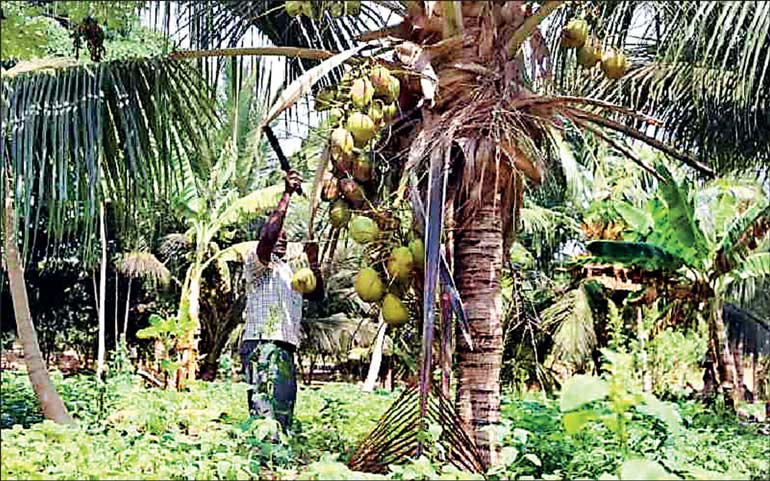Sunday Dec 14, 2025
Sunday Dec 14, 2025
Wednesday, 23 July 2025 00:26 - - {{hitsCtrl.values.hits}}

While coconut remains an integral part of the nation’s culinary identity and a key export commodity, the growers who sustain this legacy are battling mounting challenges that threaten both livelihoods and the future of the industry
 The coconut tree, deeply embedded in Sri Lanka’s cultural heritage and economy, represents more than just an agricultural crop—it is a symbol of nourishment, tradition, and national pride. But today, those who nurture this heritage are being left behind. Without decisive and inclusive action, Sri Lanka risks not only losing its position as a top global exporter but also dismantling a vital rural economy that supports millions
The coconut tree, deeply embedded in Sri Lanka’s cultural heritage and economy, represents more than just an agricultural crop—it is a symbol of nourishment, tradition, and national pride. But today, those who nurture this heritage are being left behind. Without decisive and inclusive action, Sri Lanka risks not only losing its position as a top global exporter but also dismantling a vital rural economy that supports millions
 Challenge
Challenge
Sri Lanka, often celebrated as the land of the “Tree of Life,” is facing an alarming crisis in one of its most vital agricultural sectors—the coconut industry. While coconut remains an integral part of the nation’s culinary identity and a key export commodity, the growers who sustain this legacy are battling mounting challenges that threaten both livelihoods and the future of the industry.
At the heart of the crisis lies a growing disparity between what coconut growers earn and what consumers pay. The current farm gate price of a coconut has dropped to approximately Rs. 110, while retail prices in urban markets soar between Rs. 180 and Rs. 200 per nut. This disparity has exposed the unchecked power of intermediaries—middlemen and brokers who extract significant profit while farmers barely cover costs. For many growers, the system has become unsustainable.
Questionable practices
Concerns have intensified over the recent conduct of coconut auctions held under the oversight of the Coconut Development Authority (CDA). While there was a brief increase in prices earlier this year—due to reduced production caused by whitefly infestation, coconut mites, and erratic weather patterns—this was short-lived. Prices were reportedly driven down again by deliberate manipulation from dominant buyers in the auction process. Many in the industry have raised alarm over the lack of transparency and fairness in how prices are set, leaving small-scale growers, vulnerable and voiceless.
Adding to their woes, the Government’s decision to import coconut milk, officially for re-export purposes, has raised serious red flags. Reports suggest that imported milk is being blended with local coconut products and exported under a single Sri Lankan label. This practice risks eroding the global reputation of Sri Lankan coconuts, which are prized for their unique creamy texture and distinct flavour profile—qualities not matched by lower-grade imports. A similar situation previously damaged Sri Lanka’s pepper export market when cheaper Vietnamese pepper was mixed with local produce, leading to international distrust and lost contracts.
Other adversities
Beyond pricing concerns, the cost of cultivation has become prohibitively high. A 50 kg bag of fertiliser now exceeds Rs. 8,500 and is only sufficient for 16 trees—an unsustainable equation for many medium-scale farmers. Meanwhile, coconut plantations are increasingly under siege from pests such as the red and black weevil, coconut mite, and whitefly. Labour shortages, high input costs, and rampant theft of coconuts have further strained farmers, many of whom are reducing investment in their crops or abandoning cultivation altogether.
Despite these hardships, Sri Lanka’s coconut industry remains a cornerstone of its rural economy and export portfolio. The country is the fourth largest exporter of coconuts and coconut-based products globally, with over 409,000 hectares of land under cultivation. The sector directly supports more than 700,000 people and provides indirect employment to another 135,000. In 2021 and 2022, Sri Lanka achieved record harvests of over 3.3 billion nuts. However, in 2023, production dropped below 3 billion, affecting both local supply and exports. Despite this decline, the industry still generated over $ 708 million in export earnings, highlighting its resilience and potential.
Way forward
Looking ahead, the Government has set ambitious targets for 2025, including the planting of 2.5 million new coconut trees and the reorganisation of regional cultivation societies. While this is a promising start, industry stakeholders stress that planting alone will not resolve the deeper systemic issues.
To revitalise the sector, several urgent policy interventions have been proposed. First, there is a pressing need for the Coconut Development Authority to reform its auction processes, ensuring transparency and curbing price manipulation. Second, strict enforcement of labelling regulations is essential to distinguish between local and imported coconut content, safeguarding Sri Lanka’s premium brand image in export markets. Third, the provision of subsidised fertiliser and research-backed pest control methods—supported by the Coconut Research Institute—can help farmers manage cultivation costs more effectively.
Furthermore, mechanisation incentives and low-interest loans can address labour shortages and reduce dependency on manual harvesting. Community-led security programs could help mitigate theft and protect plantations. Strengthening local farmer societies and cooperatives will also empower growers in price negotiations and quality control, fostering greater resilience within the industry.
Conclusion
The coconut tree, deeply embedded in Sri Lanka’s cultural heritage and economy, represents more than just an agricultural crop—it is a symbol of nourishment, tradition, and national pride. But today, those who nurture this heritage are being left behind.
Without decisive and inclusive action, Sri Lanka risks not only losing its position as a top global exporter but also dismantling a vital rural economy that supports millions. The call for reform is not just about economics—it is about honouring the legacy of an industry that has nourished the nation for generations.
(The writer is an Engineer with 20 years of military service and nearly two decades as Defence Cooperation Specialist at a foreign mission in Sri Lanka. He is a Fellow of the Institute of Incorporated Engineers, Sri Lanka, and holds an MBA from the Postgraduate Institute of Business Administration (PIM) at the University of Sri Jayewardenepura, along with a Master’s degree in International Relations from the University of Colombo. He has developed his coconut estate into a Model Estate in the Puttalam District. He believes in sustainable and innovative Farming and Agriculture. He can be reached at [email protected].)